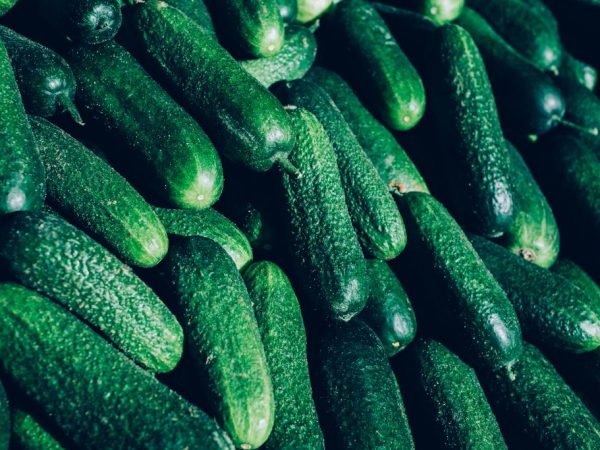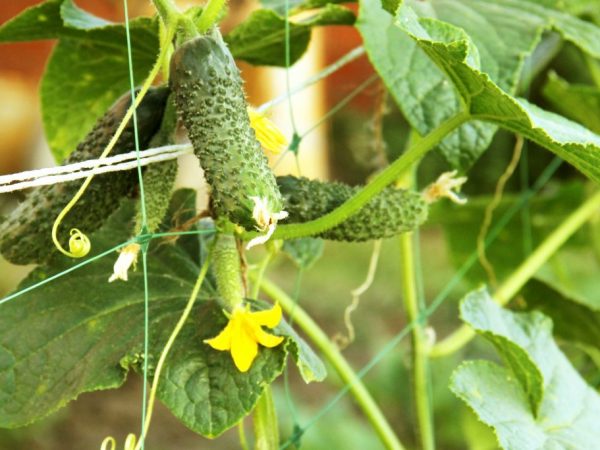Characteristics of the Ginga cucumber variety
The Ginga variety of cucumbers has proven itself quite well in agriculture. The culture is distinguished by its resistance to diseases and pests, exceptional taste, excellent yield.

Characteristics of the Ginga cucumber variety
Features of the variety
The F1 hybrid Ginga cucumber was developed by German breeders. The culture is referred to as mid-season varieties: the first cucumbers are removed by gardeners within 45-50 days from the moment the first shoots appear. This variety bears fruit within 2-3 months.
Ginga cucumbers do not need pollination. The plant has predominantly female flowers. This provides the variety with a good yield: from 1 sq. m of cucumber beds are harvested up to 6 kg of fruit.
Cucumbers are distinguished by good keeping quality and transportability.
Description of bushes
Ginga cucumber bushes have small green leaves. The variety is classified with medium-vigorous plants. There is no strong climbing behind it. The ovaries are collected in bunches.
Description of fruits
Zelentsy hybrid variety Ginga F1 small size. In length, each cucumber reaches a little more than 10 cm, in diameter - 3 cm.The weight of such zelents varies from 80 to 90 g.
The taste qualities of cucumbers of the Ginga F1 variety receive only positive reviews.
Gardeners distinguish the following features of the fruit:
- crispy flesh;
- lack of hollowness;
- bright cucumber aroma;
- lack of bitterness.
The fruits are suitable for salads, as well as for preservation.
Agrotechnics
Ginga F1 cucumber is planted directly into the soil by seed. It is recommended to allocate well-lit land plots for cucumber beds. Pre-dug up the soil and apply organic fertilizers to it. Immediately before planting cucumbers, the beds are watered with warm water.
Cultivation does not imply the use of special technologies. When growing a hybrid, a number of rules are followed:
- No need for pre-germination of seed.
- No need to thicken the planting of cucumbers. Sowing seeds is carried out according to the scheme 30 x 70 cm with their obligatory deepening to a depth of 4 cm.
- Timely pinching of lateral shoots. The shoots are removed from the main shoot until the fifth leaf appears on it. If cucumbers are grown in a greenhouse, then gardeners recommend pinching the main shoot, and do not let the side shoots go beyond the second leaf.
- Correct watering regime. During hot periods, the plant needs frequent moisture. When the night air temperature drops below 15 ° C, it is recommended to stop abundant watering.
- Timely introduction of nutrients. Vegetable growers recommend using nitrogen-containing, potash, phosphate fertilizers.
- Providing warmth. When growing crops in open ground, you need to monitor the temperature regime. Cucumbers are adapted to temperatures between 19 ° C and 35 ° C. The difference between daytime and nighttime thermometer readings should not be more than 5 points. To provide the plants with the necessary heat, they use a film cover.
Vegetable growers' tips

Tips to Help Increase Yields
Cucumber beds need to be weeded frequently: this provides oxygen access to the crop root system, and also contributes to the destruction of weeds.
Vegetable growers who want to get a harvest of gherkins no more than 7 cm in size collect cucumbers every 2 days.
Gardeners who dream of getting a harvest in large volumes and at an earlier date should grow the hybrid Ginga variety in a seedling way.
Pests and diseases
Breeders from Germany have tried to make the hybrid Ginga resistant to various diseases and pests.
Diseases
The variety is not susceptible to classic diseases of cucumber bushes. With improper care, fusarium develops in the beds.
Vegetable growers recommend preventive soil treatment. For this, special fungicides are used.
Pests
Aphids are considered insects that can harm a crop. These small parasites can colonize Ginga cucumber bushes. Control methods consist in treating the plant with solutions prepared according to folk recipes or on the basis of special preparations.
Conclusion
The crop description shows that F1 Ginga cucumbers are a versatile crop. Both beginners and experienced gardeners are able to grow the variety on their plots. There are no difficulties in cultivating a plant, and the results exceed any expectations.

